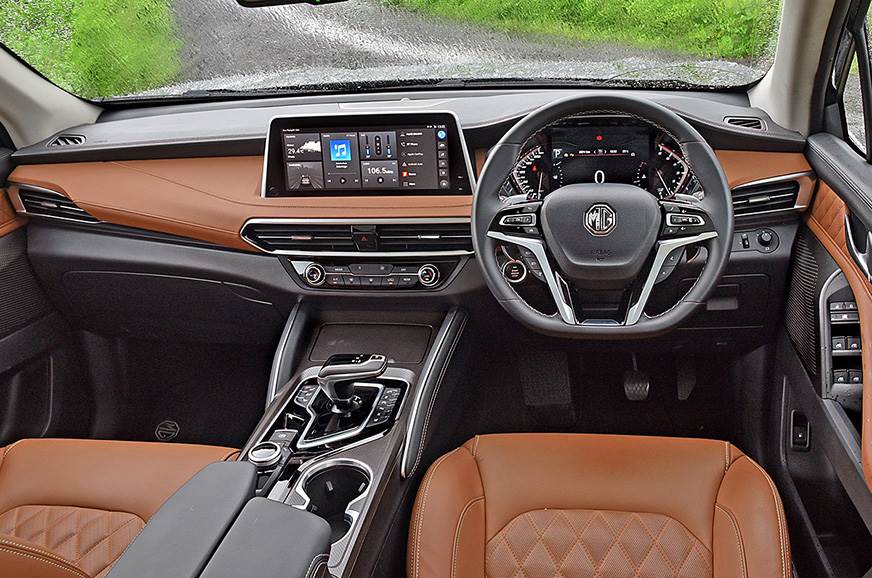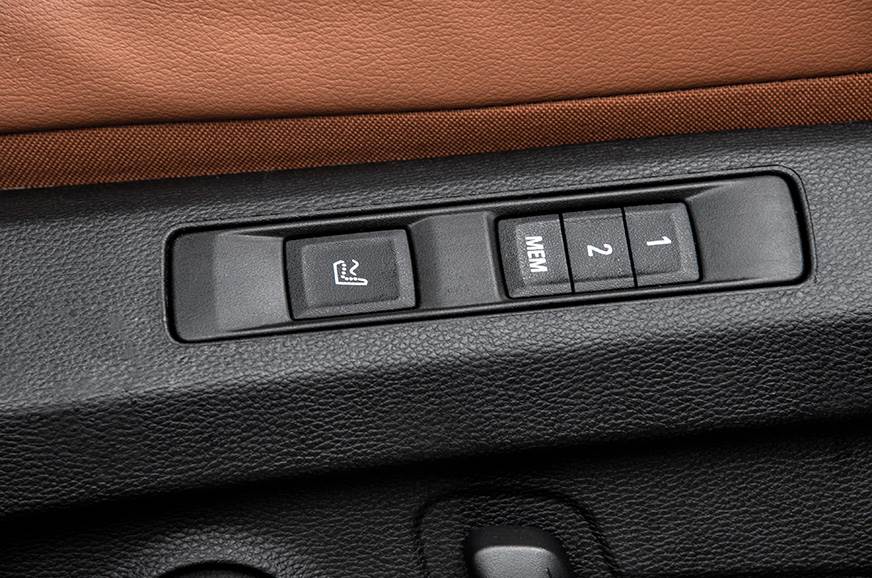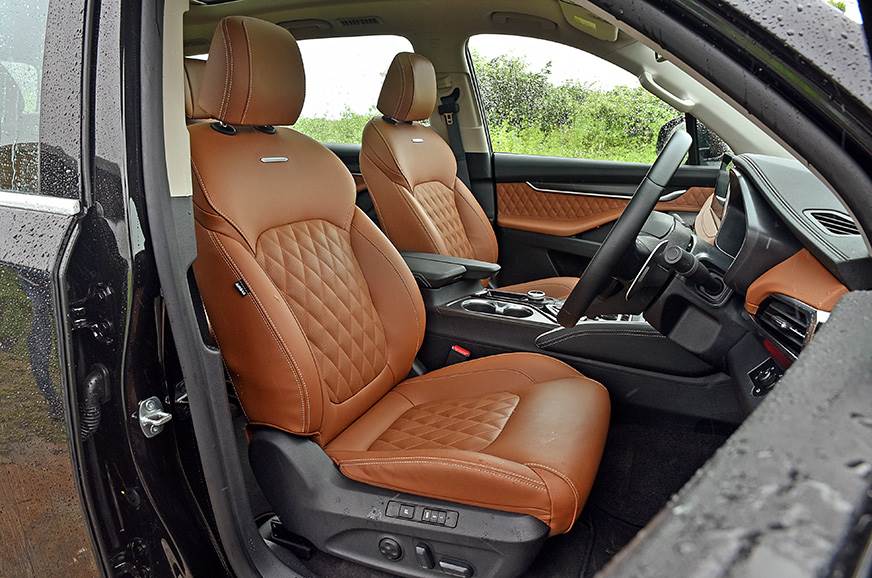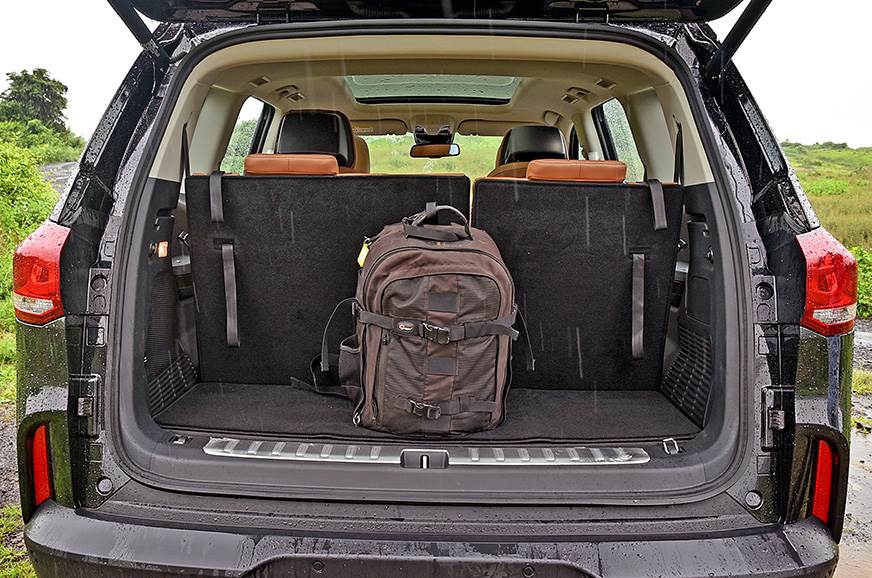Can MG’s new flagship disrupt the body-on-frame seven-seat premium SUV space?
AD
After tasting success in the sub-Rs 20 lakh SUV space with the Hector’s ‘more for less’ approach, MG is now geared up to take things to a whole new level and enter the premium, seven-seat, body-on-frame SUV segment with its all-new offering, the Gloster. MG’s underlying approach with this new SUV is similar to the Hector’s, so even this new SUV holds a distinct size, performance and premium feel advantage compared to its rivals. MG has also gone a step ahead and stuffed the Gloster with several segment-first premium features like advanced driver assistance systems (ADAS), thus far seen only on a handful of all-out luxury vehicles, to give it an edge over the competition.
The Gloster comes from the Maxus brand, owned by SAIC (the same parent as MG), and is essentially the Maxus D90 in China and the LDV D90 in Australia. It’s been rebranded for India and sold as the flagship of the Morris Garages (MG) range, with a suitably British-sounding name – Gloster.
But can the Gloster’s spec advantage on paper translate into superior performance, practicality and comfort, compared to the Mahindra Alturas G4, Ford Endeavour and the king of the segment, the Toyota Fortuner?
We put it through our exhaustive real-world tests to find out.
One of the pre-requisites in a vehicle of this class in India is the ever-so-important road presence, and the MG Gloster delivers a healthy dose of it. Its gargantuan dimensions of 4,985mm length, 1,867mm height and 2,950mm wheelbase are all best-in-class, with only the 1,926mm width being slightly less than the Mahindra Alturas G4.

The 19-inch wheels are the largest in this segment, but still look a little dwarfed in the cavernous wheel arches. Certain elements, like the dummy quad exhausts, are nicely integrated into the design and lend it a sporty look.

Despite its imposing size, however, what the MG Gloster lacks is a distinctive design. There’s no visual link to the other MG models on sale in India (there wouldn’t be, as each car is sourced from a different SAIC-owned brand), and some of the details look a bit derivative of other brands too. The chrome lining around the window surrounds and front grille add a bit of flash but it’s all too generic, and the Gloster, though too huge to go unnoticed, doesn’t wow you with its design.

There’s nothing subtle about the way the Gloster flaunts its identity. You’ll find an overdose of badges – as many as five at the rear – a large MG logo, a 4WD badge, an ‘ADAS’ badge denoting the advanced driver aids, and the one that adorns all MGs – ‘Internet Inside’. You’ll also find the word ‘Gloster’ spelled large across the width of the tailgate. And like with the Hector, MG is at pains to shout out the brand’s origin – there’s a pair of Union Jack badges on the front flanks that say ‘Brit Dynamic.’
You really need to climb into this SUV, as is the case with most ladder-frame SUVs, but to make things a bit easier, the powered driver’s seat automatically slides all the way back on unlocking the vehicle. And just like the exteriors, the Gloster’s cabin is dressed to impress. There’s a generous usage of double-stitched tan leather on the dashboard, door pads, and seats, which make a great first impression. Quilting on the seats and brushed aluminium trims further uplift the premium experience. The dashboard design strikes an uncanny resemblance to any modern BMW, more so in the way the 12.3-inch trapezoidal touchscreen is placed and styled. However, this isn’t something that MG buyers will complain about. The instrument cluster features an 8.0-inch colour screen between the dials that is crisp, fluid and full of relevant information. In fact, this screen overshadows the ordinary looking analogue tachometer and speedometer relegated to the sides of the binnacle. Apart from the usual trip and fuel computer info, it can show you drive modes, ADAS functionality (more on this later), tyre pressure, media and phone info, and much more.

While perceived quality is generally pretty good, when you take a closer look you realise that some of the materials and plastics used don’t feel premium enough for a car of this price. Even the switchgear on and around the button-heavy steering wheel feels a bit low-rent and you’ll find yourself accidentally hitting the one with the * on it regularly, resulting in a call back from MG’s prompt and patient helpline. Attention to detail is missing in the key fob too – it has no proper markings, which makes pressing the right button a bit of guesswork, especially in the dark.

The front seats are wide and generous, offering a plethora of adjustments, with the driver’s side being powered with memory functions, as well as heating/cooling and massage function, while the passenger’s seat has to make-do with only a heating function.

But as you try to settle in for a long drive, you’ll notice the lumbar support, even at its lowest setting, is a bit excessive, and the cushioning all round is stiff and hard. The massage, as a result, feels more like physiotherapy than relaxation.

Still, even with the seat motored down to its lowest setting, forward visibility is great, thanks to upright A-pillars and a relatively low-set dash. Even the giant wing mirrors have enough of a gap from the Gloster’s body so as to not cause a huge blind spot. Rear visibility, however, is hampered by the big head restraints on the rear seats.
This top-spec Savvy variant is equipped with a pair of captain’s chairs in the second row, which are almost as generous in size as the ones in front. They can be reclined a fair bit and have a long range of fore-and-aft sliding travel, allowing for limousine legroom. For those who are largely chauffeur-driven, the combination of captain’s seats and overall space on offer makes the Gloster’s middle row very comfortable. But again, like the front seats, the second-row pair feel noticeably hard and you don’t quite sink into them. Some lower variants offer a bench seat in the middle row.

In terms of practicality, hidden in the seat bases are cupholders and storage for tablet computers; you get a third climate zone for the rear cabin, and of course, some charging provisions, as well as storage in the door bins and front seatback pockets. Window sunshades, however, are sorely missed.
Tilting and sliding the second row forward does allow you decent access to the last row, but it’s perhaps easier to just walk between the middle-row seats. When it comes to outright space, just like with the middle row, this is easily the best third row among SUVs in this segment, and perhaps even among larger, full-size luxury SUVs. You sit a bit low, thigh support isn’t great, and there’s no place to tuck your feet (which is all par for the course), but headroom is decent and knee room – with the second row in its mid-way position – is so good, you’ll forgive it for its shortcomings. The large (fixed) glass area here, too, allows a lot of light through, further adding to the sense of space.

You get cupholders, USB and 12V charging, and dedicated AC vents back here, and though it’s comfortably wide enough for three kids, MG has given it just two seatbelts and head restraints.
With all that cabin room, it’s understandable that there’s not a lot of space for luggage with all rows up; but again, it’s more than what the competition offers, and you can fit a couple of strollers and soft bags. Flip the third row down, though, and space is vast. You even get a powered tailgate with hands-free opening, and a retractable luggage cover that stows away under the boot floor.

All told, the Gloster is by far the most spacious SUV in its class; what amplifies the sense of space here is the enormous panoramic sunroof, which has become an MG signature.
MG has stuffed the Gloster to its gills with features, making it the best equipped SUV in its class. The 12.3-inch touchscreen infotainment system alone packs in a lot – apart from being the largest, it gets Apple CarPlay, Android Auto and MG’s iSmart suite of connected-car tech. This includes a smartphone app for remote functionality, intelligent voice commands, an onboard e-SIM, the Gaana music-streaming app built in, live weather status, and MapMyIndia-sourced navigation with real-time traffic data.

What’s more is that it gets the very helpful 360-degree cameras, but the camera resolution leaves a lot to be desired and the display quality is poor. Among the nicer features are the largest-in-class panoramic sunroof, a heated, cooled and massaging driver’s seat, which is powered and gets a memory function. Then there’s three-zone climate control, wireless phone charging, a 12-speaker audio system, 64-colour ambient lighting, tyre pressure monitoring and an electronic parking brake with auto hold. An electric tailgate, auto LED headlamps, rain-sensing wipers, a heated passenger seat and paddle shifters are also part of the equipment list.

And then there are the Advanced Driver Assisted System (ADAS) features. Among these are some that we’re more familiar with, like driver fatigue detection, auto parking assist, blind-spot warning function, and lane departure warning. Then there’s frontal collision warning, adaptive cruise control, and autonomous emergency braking function. See the box for more details on how the advanced driver assistance systems in the Gloster work.
The in-house-developed, 1,996cc, twin-turbo diesel engine under the hood of the Gloster punches out 218hp and 480Nm of torque, which again are the highest outputs for this sort of SUV. Drive goes to the rear via an 8-speed torque-converter automatic, with an on-demand 4WD system engaging when necessary.
The Gloster isn’t merely impressive on paper, but even in our tests it dispatched the 0-100kph sprint in just 11.21sec, which is as quick as the Mahindra Alturas G4, despite being a full 368kg heavier. In roll-on acceleration, 20-80kph was dispatched in a reasonably quick 6.57sec and 40-100kph in 8.77sec after a firm kick down on the accelerator; almost as quick as the much lighter Mahindra (6.41sec, 8.62sec) and much quicker than the Ford and Toyota.
But outright performance aside, this twin-turbo engine has a particularly weak bottom end, and off the mark, it feels unusually sluggish. Below 2,000rpm, no amount of poking the accelerator will get it to pick up the pace, and this is only exacerbated by the slow responses of the gearbox, which often takes time to figure out which gear you need to be in. Drop the revs to crawling speeds, and no matter how much you prod the accelerator, it almost never downshifts to the extremely short first gear ratio, and that’s where the lag and the poor calibration make their presence felt. It is only once you pass 2,000rpm that all of the boost comes in and you surge forward. The slug of torque, although strong, is quite linear in the way the power flows in.
The highway is where this slow-revving engine, which won’t spin beyond 3,900rpm, feels most comfortable. Its big reserves of torque and long-legged gearing mean it can cruise effortlessly in seventh or eighth gear, which makes it the ideal SUV for those long outstation trips with the family. Gearshifts on the move are unobtrusive and you’ll always have enough power available, should you want to go faster. There is some manual control on offer via a set of paddle shifters, which really come in handy to drop two or three gears for a quick overtake. However, it doesn’t like overly aggressive downshifts; if the revs are too high, it won’t comply.
There are also Eco and Sport driving modes for the Gloster’s on-road performance, but in practice, we couldn’t discern a tangible difference between engine or gearbox performance, mode to mode.
The brakes are well-judged and very impressive in the way they shed speed. The heavy Gloster hauled itself down to a standstill from 80kph in just 2.56sec and 25m, which is exceptionally good, considering its weight.

There is a locking rear e-diff that you can engage with a button on the centre console, but apart from that, your only control of the 4WD system is via a set of pre-set drive modes – Sand, Snow, Rock and Mud. There’s no manually selectable 4WD or low-range, like you get in some rivals. And while its clever four-wheel-drive system, coupled with the clever off-roading gadgetry, ensures that the Gloster tackles some moderate-level obstacles and sticky scenarios, a mountain-goat like the Toyota Fortuner it is not, and the MG’s hefty 2,518kg kerb weight doesn’t help.
This is where the MG Gloster begins to shine. First, there’s the refinement, both from the engine and the running gear, at low speeds or high, which is really exceptional, with engine, wind and road noise very effectively muted.
The ride quality is also really good. Sure, you’ll get some of that lumpiness typical of a ladder-frame SUV at low speeds, but it smoothens out admirably as you go faster and isn’t nearly as choppy or bouncy as some of the others out there. And just as you’d expect from a hardy body-on-frame SUV, this one isn’t shy to go off the beaten path, and it suppresses broken roads without batting an eyelid.

There’s a fair bit of body roll, which you would expect from such a tall vehicle, but you can still corner confidently, as the steering has a reassuringly fluid feel to it. In fact, the steering is the big surprise, because it is very light and allows you to come to grips with this behemoth’s dimensions in almost no time. And it manages to do this while giving you a reasonable amount of feedback and confidence at speed – not too sharp to be edgy, but not too slow to be ponderous either.
In fact, it’s safe to say the Gloster has the best ride and handling mix among all the large, ladder-frame SUVs on the market right now.
Besides the fact that the twin-turbo engine needs to haul the Gloster’s 2.5-tonne bulk, its sluggish low-speed responses, short gearing, and the constant on- and off-boost driving in the city, resulted in a fuel-efficiency of merely 8.4kpl in our tests. On the highway, the MG cruises a lot more effortlessly, so the motor was spinning at 1,750rpm in eighth gear at 100kph, and returned a modest 10.8kpl.
Although it isn’t branded, the OEM audio system on the MG Gloster holds its own against some pricier options. The cavernous cabin is filled up well by 12 speakers, including a subwoofer in the boot and a centre channel speaker in the dashboard. It’s a tonally balanced system that impresses with its low-end grunt and definition. It’s only at the top-end of the frequency spectrum that it starts sounding a bit unrefined and sibilant, but the on-board graphic EQ can help tame that easily. Apple CarPlay and Android Auto are supported but the 12.3-inch screen could be more responsive in its touch sensitivity and also brighter under direct sunlight. But its unique feature is a built-in Gaana app that also allows for song search via voice commands, which are a hit-or-miss affair. More USB ports wouldn’t go unappreciated either, but you do get to use up to 70 features through your smartphone, thanks to the iSmart 2.0 connected car app.
The ADAS or Advanced Driver Assistance Systems in the Gloster have some features that we’re more familiar with, like driver fatigue detection, which suggests the driver take a break via a prompt on the MID after it senses the car has been on the move for a long time, or it detects erratic driving behaviour. The next feature is the auto parking assist, which is essentially a hands-free park-in or park-out function for parallel or perpendicular spaces, where the driver merely controls the vehicle speed and forward/reverse gears, and the car steers itself.

It also gets a blind-spot warning function, which flashes a light in the wing mirror to make you aware of a vehicle in your rear three-quarter view, and if you are indicating, you won’t hear the ticking sound if there is an object in your blind spot. Then there’s lane-departure warning, which alerts you with a graphic on the MID as well as an audible warning when it detects you are straying out of your lane without indicating. What’s nice is that this system even detects washed off or faint lane markers.

There’s a self-explanatory frontal collision warning, which throws up a prompt on the MID accompanied by an audible warning, if it senses that the car could possibly have a head-on collision. And finally, adaptive cruise control, which maintains a set distance from the car in front of you and adjusts your speed to match, even down to a complete halt. This works brilliantly for the most part and will even slam the brakes if an errant driver suddenly cuts in front of you. But if the traffic in front is a bit slower than your set speed, the Gloster’s system, while maintaining a safe distance, will remain at a lower gear than usual, in an attempt to immediately reach the preset speed when the traffic clears. This on-guard behaviour takes away from a relaxed cruise control experience to an extent. The autonomous emergency braking function works extremely well while using adaptive cruise control, but we still wouldn’t advise that you rely on this system a hundred percent.

Whilst the ADAS features work extremely well for the most part, the warning alarms and parking sensors are too loud and can get very annoying, and there’s no way to lower the volume. In fact, even something like the turn indicators sound excessively loud.

All things considered, the MG Gloster comes across as a pleasant surprise. It could very well have turned out to be a collection of impressive specs with no substance to back it up, but that simply hasn’t been the case.
The only real fly in the ointment appears to be the sluggish response at low speeds, which, coupled with the gargantuan dimensions, can make city driving pretty taxing. Also, the premium looking cabin gives an illusion of luxury, and the tactile feel of some bits in the cabin should have been better for a car at this price point.
Refinement and ride quality are standouts, as is interior space, and then of course there’s the long equipment list, which is enough to shame far more expensive SUVs.
This top-spec Savvy version, however, will be priced just above the established competition, at around Rs 37 lakh (ex-showroom). That’s a pretty bold move, but MG is hoping buyers will see value in the size, space, performance, comfort and, of course, the equipment.
The Gloster might not enjoy the same brand equity as the Toyota Fortuner, and it might not be as effortless off the road either, but as a seven-seat family tourer, MG’s latest SUV is as good as it gets.
Tell us what you think.